Wild violets are perennial flowers that bloom in the spring and spread into non-infested areas via underground stems. However, curbing their growth is a must, and the question is, which herbicide to use? We've done the work to bring you the answer.
The most effective herbicide for wild violets should be a broadleaf containing Triclopyr like Triclopyr 4 Brush killer. This particular professional-grade herbicide targets only the weed without harming your other vegetation.
Continue reading as we elaborate on the herbicide and its application to remove this aggressive weed.
What Herbicides To Use In Order To Get Rid Of Wild Violets
Violets grow well in fertile and moist soils but can also do well in full sun with partial shade, spreading via rhizomes. The autumn season is ideal for controlling wild violets.
However, no pre-emergence herbicides are available to control wild violets. Several herbicides are available for post-emergence control.
Herbicides adhere better on violets because they have a waxy leaf surface. It improves the herbicide mixture weed control.
Herbicides with Pyridine chemistry, such as Triclopyr, Fluroxypyr, and others, have the most success against wild violets. Some examples of these herbicides are as follows:
- Escalade 2, a broadleaf killer containing 2, 4-D, or Dicamba; they selectively kill the violets while leaving the grass/desired vegetation unharmed
- T-Zone contains Triclopyr + Sulfentrazone + 2, 4-D + Dicamba
- Drive is another excellent wild violet herbicide that contains Quinclorac
Check out this Quinclorac weed killer on Amazon.
- Confront consists of clopyralid + Triclopyr
- Momentum 4-Score has Fluroxypyr + triclopyr + sulfentrazone + 2,4-D
Herbicides applied in the fall penetrate deeper into the taproot and provide better control. Unfortunately, applications during summer or spring only burn back the leaf tissue, and the weeds will regrow. Ensure you treat the wild violets repeatedly over multiple years to completely eliminate them.
How To Identify, Control, And Kill Wild Violets
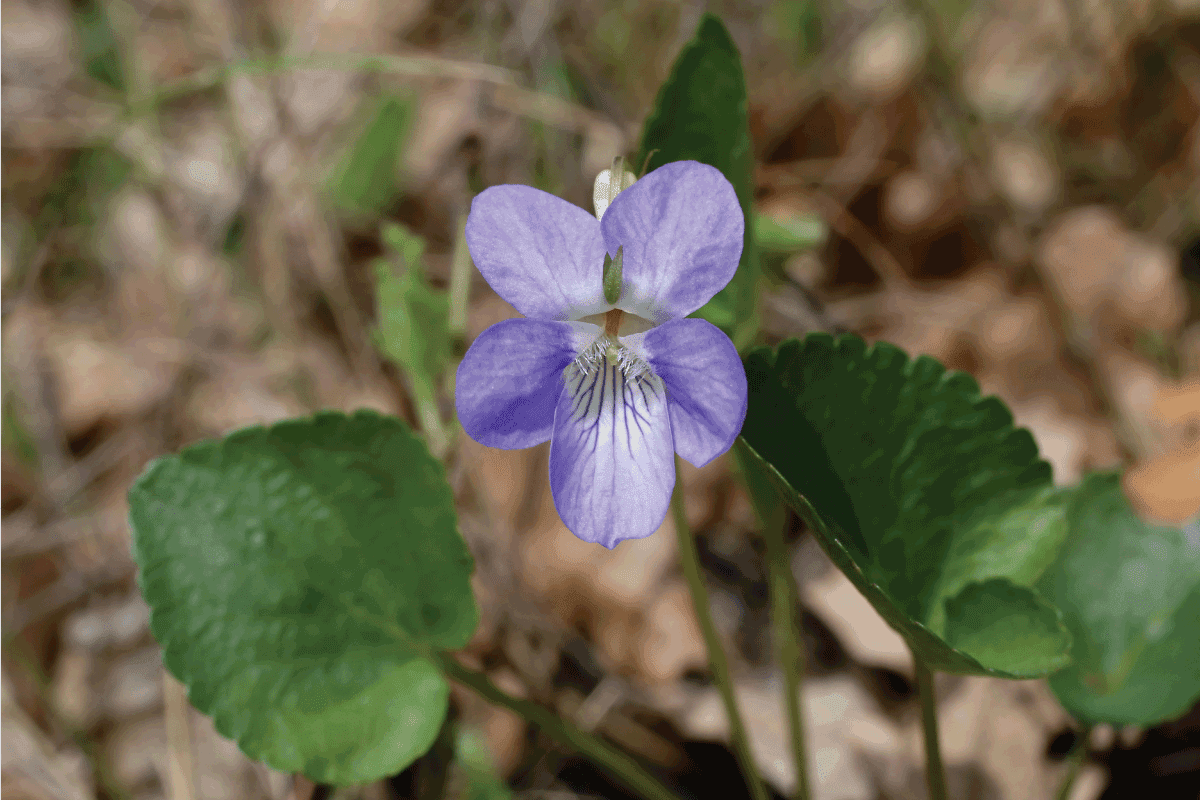
Identifying
Wild violets can be tricky to identify if you are unfamiliar with them. Violets have low-growth habits with heart-shaped, small dark purple, white, yellow, or lavender flowers with waxy leaves growing low to form cones.
Their flowers grow on stalks that sprout from plant growth points at the base. Each flower has five petals, two of which have white hairs at the bottom.
The plants typically range from two to twelve inches in height, considering they grow under the right conditions. They have rhizomes with fleshy stems underground that assist them in spreading.
Controlling
There are a few techniques to control the growth of wild violets in your lawn:
Apply mulch to smother the weed and prune surrounding vegetation to eliminate any shade that can help the wild violet thrive. Practice the best lawn care and improve drainage in your lawn to prevent unnecessary moisture that could encourage the growth of these weeds. Hand weeding is the least effective way to get rid of wild violets in your yard.
Killing
Now that you know what you are eliminating, it's time to eliminate them with no chance of regrowth. Using chemical weed killers such as broadleaf herbicides containing Triclopyr is one of the best methods of killing wild violets.
Use the chemicals with utmost caution due to the toxicity level, which could harm humans, plants, and animals. Always wear appropriate protective gear before handling any herbicide chemicals. They can also cause contamination of fresh and underground water.
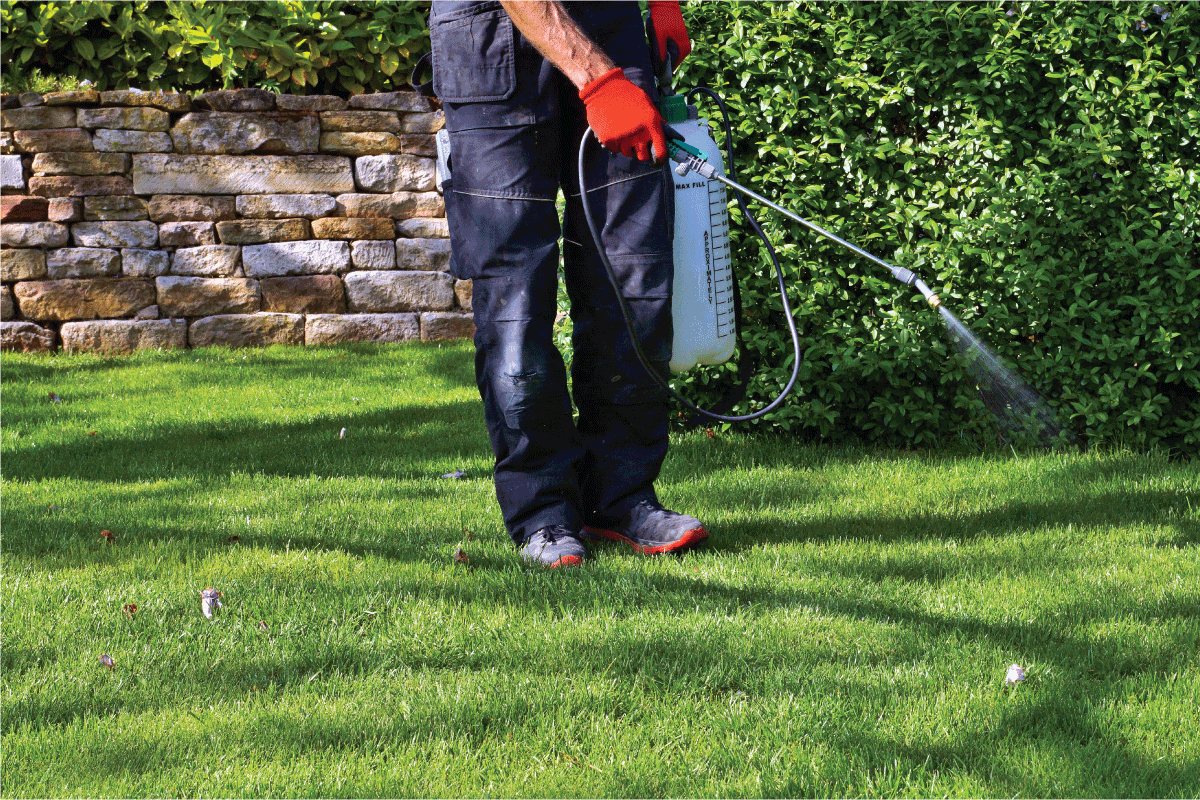
Tools And Protective Gear For Eliminating Wild Violets
Herbicides can get into the body through different routes, like the eyes, lungs, skin, and mouth. The most common form of entry is through the skin.
Herbicides are usually more concentrated during the mixing process, which increases the likelihood of injury. Body parts such as the head and the area between the navel and mid-thighs absorb these chemicals very quickly and therefore require additional protection.
If the chemical is spilled in any of these areas, immediately wash it off and change your clothes. Wear appropriate personal protective equipment.
The best protective gears consist of the following:
- Work gloves
- Apron and boots
- Breathable mask
- Face shield/goggles
Have a look at this protective suit on Amazon.
Some tools that you might need for controlling or getting rid of the wild violets are:
- Pump or garden sprayer
- Garden fork
- Garden hose
- Pruning shears
- Rakes
Click here to see this battery-powered lawn sprayer on Amazon.
How To Get Rid Of Wild Violets Organically
It is possible to get rid of wild violets without using chemicals. These environmentally-friendly and safe methods help protect you and your family, especially if you have toddlers and pets running around the yard.
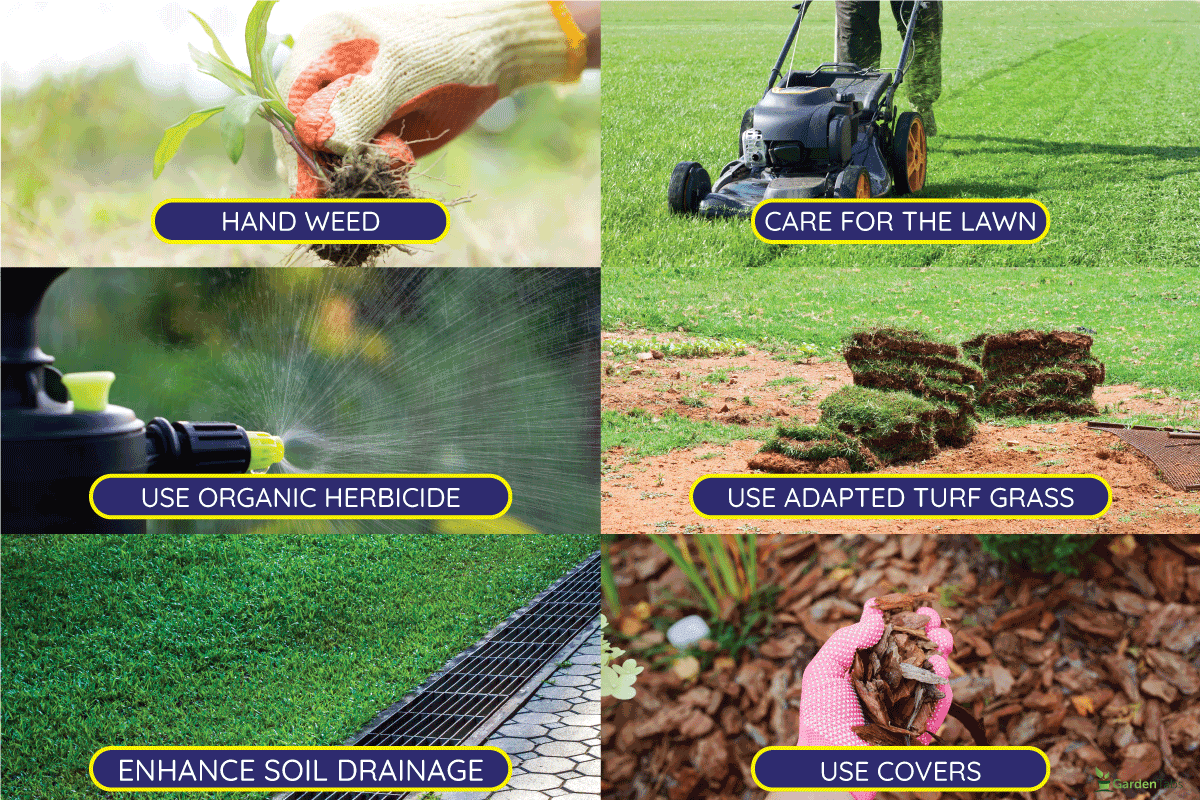
Here are a few organic ways to eliminate wild violets or other weeds.
Hand Weed
Weeding is a very time-consuming exercise, but it works effectively. However, few gardeners have the time or energy to weed their lawns as consistently as needed. Consider hiring someone to assist with this task.
Use Organic/Natural Herbicides
Should the hand weeding not work as expected, try environmentally-friendly or organic herbicides. You could use a DIY herbicide on the weed or spread corn gluten to prevent further germination.
Enhance Soil Drainage
Wild violets prefer shady and moist conditions, especially the soil in your yard/lawn that is not well drained. Improving its seepage can assist other vegetation in thriving while limiting violet growth.
Mixing coarse organic material like sawdust or sand into your garden soil helps it drain better. Alternatively, you can improve soil drainage by using an aerator with hollow tine to get rid of soil plugs, thus allowing water to flow through.
Care For The Lawn
In a healthy lawn, weeds such as wild violets are hard to grow. To ensure optimal growth, mow the grass regularly and practice other maintenance precautions.
Use Adapted Turf Grass
When your lawn is beyond repair, replacing it with a new type of grass that's highly adapted to the climate and your region area would be best. During replacement, you need to eliminate all the weeds.
Use Covers
Smother the weeds with several layers of cardboard, newspapers, or mulch. Thick layers of mulch help suffocate any remaining tiny bits of roots or the plant within a day or two. However, this method can take longer to choke the weeds. Be patient to achieve a weed-free plant bed or lawn.
Read this post for more information on mulch: Gorilla Hair Mulch: The Ultimate Guide [Inc. Pros, Cons, Applications, And Safety]
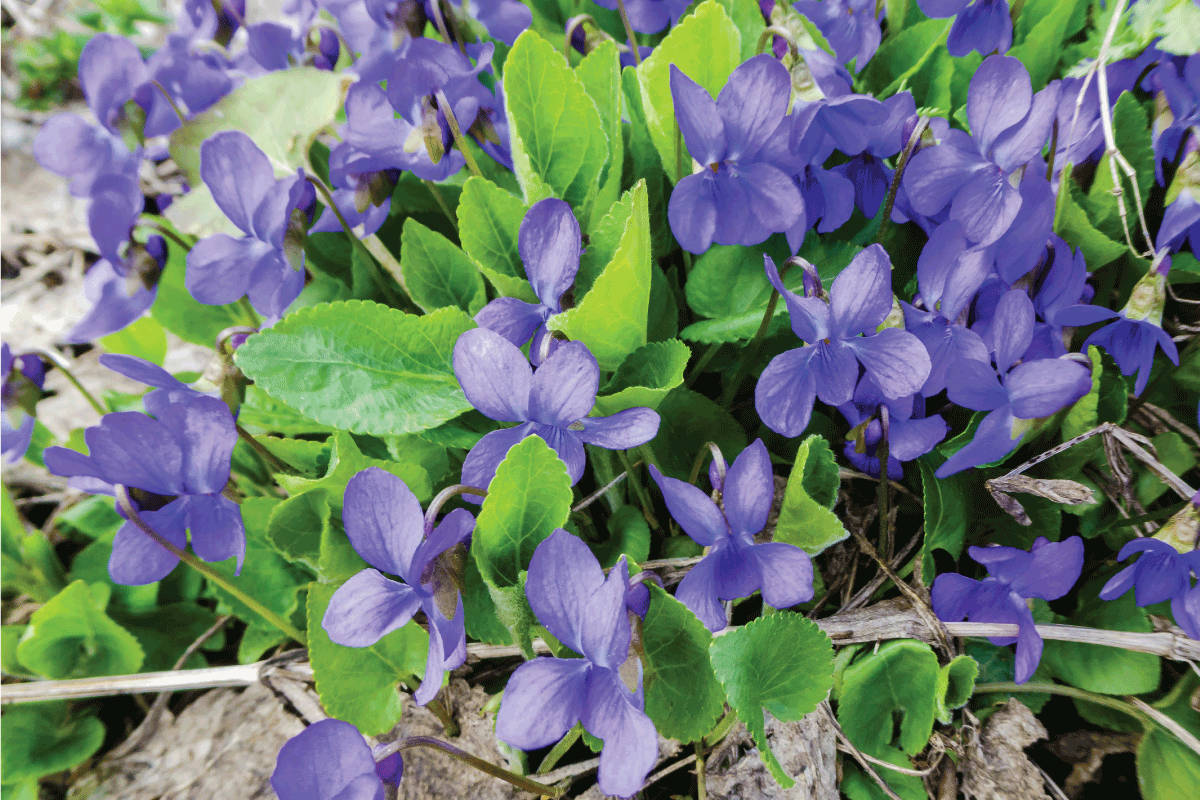
What Kills Wild Violet, Not Grass?
You want to get rid of the wild violets and save your grass from the unhealthy competition brought by the weeds. You can keep up with the following:
- Regular lawn feedings: Provide the nutrients your grass needs to grow thick and strong while crowding out weeds like wild violets.
- Hand digging: After ensuring the lawn is moist, use a garden hoe/fork to remove the entire root system. It only removes the wild violets, leaving the grass to thrive.
- Drainage: Because wild violets thrive in moist soil, improving the drainage of your garden or lawn will keep these plants at bay. However, water your lawn sparingly.
- Pruning: Wild violets thrive in light shade, where grass struggles to grow. Trim overgrown trees and shrubs to enable more sunlight to reach lawn areas where flowers spring up.
- Selective herbicides: Use a broadleaf killer that contains 2, 4-D, or Dicamba to destroy the violets directly.
Can You Use Hot Water, Vinegar, Lime, Or Borax To Eliminate Wild Violets?
Gardeners and homemakers are always searching for ways to cut costs and run their households efficiently. The quest for affordable and DIY herbicides has led to discovering a few alternative ways to kill wild violets.
Drenching wild violets with boiling water is a safe way to eradicate the wild violets in the lawn. If this doesn't work as expected, use horticultural vinegar. It's highly recommended as it contains more acetic acid than the regular ones in grocery stores. Typically, it has 20% acetic acid, sufficient to kill plants.
Some horticultural vinegar brands contain a soapy carbohydrate. It acts as a surfactant that lowers surface tension and permits the homemade weed killer to stick to the wild violets better.
Ideally, mix 20% vinegar with 80% water. If the horticultural vinegar lacks a surfactant, add one teaspoon of a non-ionic surfactant or dishwashing liquid for every gallon of water used.
Borax is not a weed killer. However, community reviews imply that if properly applied, it's effective. Borax is a laundry agent, but you could use it if you are out of options. Mixing ten ounces of borax in two and a half gallons of water gives you a homemade herbicide.
Would Wild Violets Kill Other Plants?
Plants compete for water and nutrition with weeds such as wild violet. Handfuls of violets are charming, but a garden or lawn full of them vanishes the charm quickly.
A few species create plump overground rhizomes that choke any other plants, mainly the grass and azaleas. Wild violets can indirectly kill the plants when a non-selective herbicide is used to kill them.
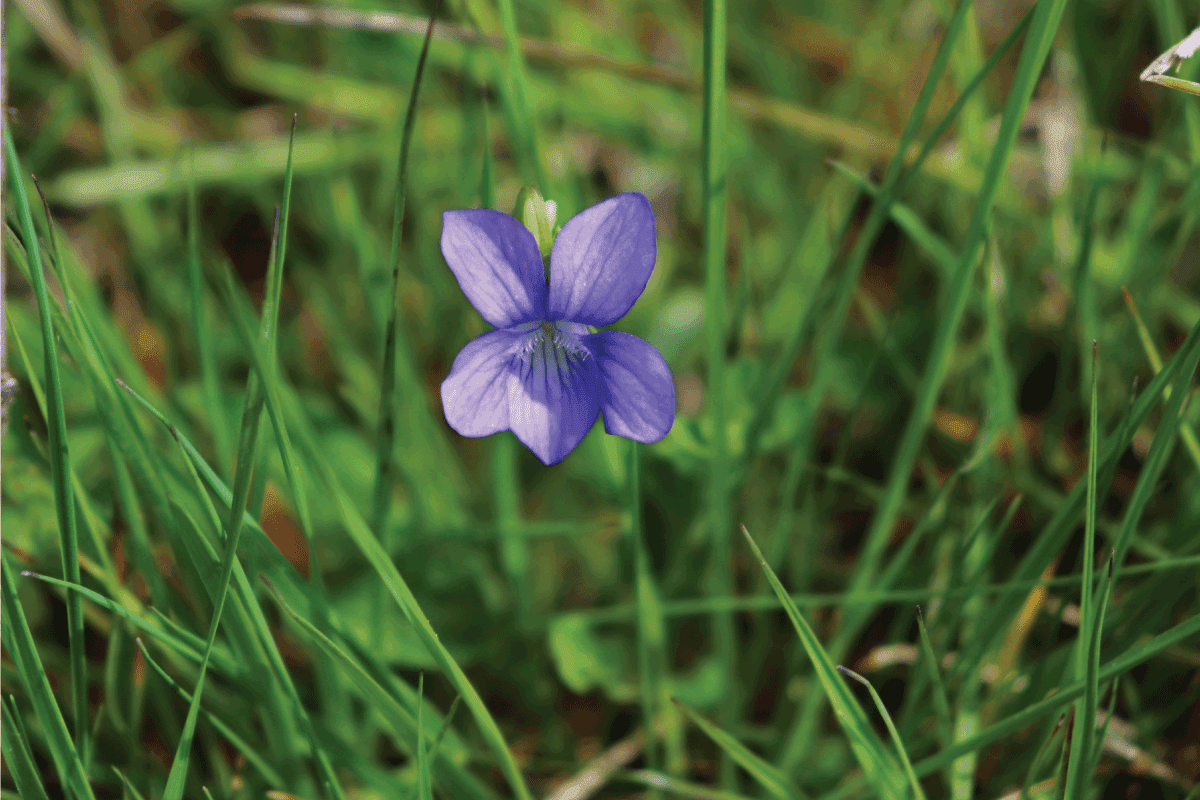
In Closing
Controlling wild violets in an established yard can be difficult due to their underground rhizomes. For effective control, you should apply post-emergence herbicides routinely.
Always refer to the product label for proper product use, mix compatibility, and grass tolerance. Use a broadleaf killer containing Triclopyr to treat growing wild violet. Reduce shade, improve soil drainage, and mow on a high setting to deter wild violet growth.
Check out these other posts before you go:



